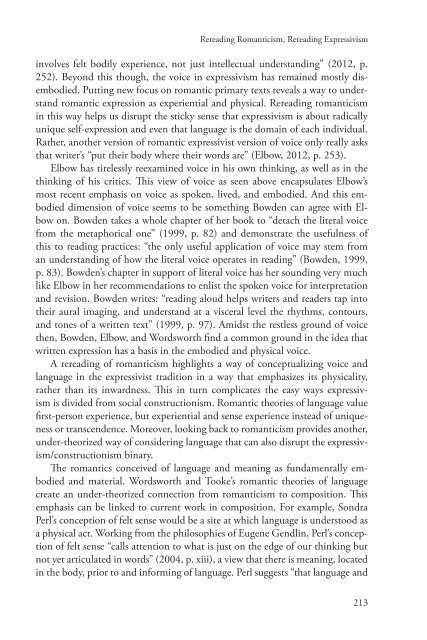Critical Expressivism- Theory and Practice in the Composition Classroom, 2014a
Critical Expressivism- Theory and Practice in the Composition Classroom, 2014a
Critical Expressivism- Theory and Practice in the Composition Classroom, 2014a
Create successful ePaper yourself
Turn your PDF publications into a flip-book with our unique Google optimized e-Paper software.
Reread<strong>in</strong>g Romanticism, Reread<strong>in</strong>g <strong>Expressivism</strong><br />
<strong>in</strong>volves felt bodily experience, not just <strong>in</strong>tellectual underst<strong>and</strong><strong>in</strong>g” (2012, p.<br />
252). Beyond this though, <strong>the</strong> voice <strong>in</strong> expressivism has rema<strong>in</strong>ed mostly disembodied.<br />
Putt<strong>in</strong>g new focus on romantic primary texts reveals a way to underst<strong>and</strong><br />
romantic expression as experiential <strong>and</strong> physical. Reread<strong>in</strong>g romanticism<br />
<strong>in</strong> this way helps us disrupt <strong>the</strong> sticky sense that expressivism is about radically<br />
unique self-expression <strong>and</strong> even that language is <strong>the</strong> doma<strong>in</strong> of each <strong>in</strong>dividual.<br />
Ra<strong>the</strong>r, ano<strong>the</strong>r version of romantic expressivist version of voice only really asks<br />
that writer’s “put <strong>the</strong>ir body where <strong>the</strong>ir words are” (Elbow, 2012, p. 253).<br />
Elbow has tirelessly reexam<strong>in</strong>ed voice <strong>in</strong> his own th<strong>in</strong>k<strong>in</strong>g, as well as <strong>in</strong> <strong>the</strong><br />
th<strong>in</strong>k<strong>in</strong>g of his critics. This view of voice as seen above encapsulates Elbow’s<br />
most recent emphasis on voice as spoken, lived, <strong>and</strong> embodied. And this embodied<br />
dimension of voice seems to be someth<strong>in</strong>g Bowden can agree with Elbow<br />
on. Bowden takes a whole chapter of her book to “detach <strong>the</strong> literal voice<br />
from <strong>the</strong> metaphorical one” (1999, p. 82) <strong>and</strong> demonstrate <strong>the</strong> usefulness of<br />
this to read<strong>in</strong>g practices: “<strong>the</strong> only useful application of voice may stem from<br />
an underst<strong>and</strong><strong>in</strong>g of how <strong>the</strong> literal voice operates <strong>in</strong> read<strong>in</strong>g” (Bowden, 1999,<br />
p. 83). Bowden’s chapter <strong>in</strong> support of literal voice has her sound<strong>in</strong>g very much<br />
like Elbow <strong>in</strong> her recommendations to enlist <strong>the</strong> spoken voice for <strong>in</strong>terpretation<br />
<strong>and</strong> revision. Bowden writes: “read<strong>in</strong>g aloud helps writers <strong>and</strong> readers tap <strong>in</strong>to<br />
<strong>the</strong>ir aural imag<strong>in</strong>g, <strong>and</strong> underst<strong>and</strong> at a visceral level <strong>the</strong> rhythms, contours,<br />
<strong>and</strong> tones of a written text” (1999, p. 97). Amidst <strong>the</strong> restless ground of voice<br />
<strong>the</strong>n, Bowden, Elbow, <strong>and</strong> Wordsworth f<strong>in</strong>d a common ground <strong>in</strong> <strong>the</strong> idea that<br />
written expression has a basis <strong>in</strong> <strong>the</strong> embodied <strong>and</strong> physical voice.<br />
A reread<strong>in</strong>g of romanticism highlights a way of conceptualiz<strong>in</strong>g voice <strong>and</strong><br />
language <strong>in</strong> <strong>the</strong> expressivist tradition <strong>in</strong> a way that emphasizes its physicality,<br />
ra<strong>the</strong>r than its <strong>in</strong>wardness. This <strong>in</strong> turn complicates <strong>the</strong> easy ways expressivism<br />
is divided from social constructionism. Romantic <strong>the</strong>ories of language value<br />
first-person experience, but experiential <strong>and</strong> sense experience <strong>in</strong>stead of uniqueness<br />
or transcendence. Moreover, look<strong>in</strong>g back to romanticism provides ano<strong>the</strong>r,<br />
under-<strong>the</strong>orized way of consider<strong>in</strong>g language that can also disrupt <strong>the</strong> expressivism/constructionism<br />
b<strong>in</strong>ary.<br />
The romantics conceived of language <strong>and</strong> mean<strong>in</strong>g as fundamentally embodied<br />
<strong>and</strong> material. Wordsworth <strong>and</strong> Tooke’s romantic <strong>the</strong>ories of language<br />
create an under-<strong>the</strong>orized connection from romanticism to composition. This<br />
emphasis can be l<strong>in</strong>ked to current work <strong>in</strong> composition. For example, Sondra<br />
Perl’s conception of felt sense would be a site at which language is understood as<br />
a physical act. Work<strong>in</strong>g from <strong>the</strong> philosophies of Eugene Gendl<strong>in</strong>, Perl’s conception<br />
of felt sense “calls attention to what is just on <strong>the</strong> edge of our th<strong>in</strong>k<strong>in</strong>g but<br />
not yet articulated <strong>in</strong> words” (2004, p. xiii), a view that <strong>the</strong>re is mean<strong>in</strong>g, located<br />
<strong>in</strong> <strong>the</strong> body, prior to <strong>and</strong> <strong>in</strong>form<strong>in</strong>g of language. Perl suggests “that language <strong>and</strong><br />
213


















